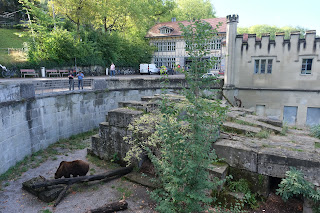To the center of Switzerland
IC60403 links Amsterdam in the Netherlands with Basel in Switzerland. It leaves Utrecht at 9 pm and arrives in Basel early in the morning. It is one of the few night trains where you can travel without reservation. In my early years I would not have hesitated to just hop on the train. However, old age comes with a desire for comfort. Unfortunately it turns out that all the beds or couchettes are already sold out. However, I am still able to make a reservation for a seat. It turns out to be a big advantage. In Germany the train stops frequently at the different stations along the Rhine and gets very full. Like in the old times some travelers spent their night on the floor of the entrance cubicle. And this was during the week. If there would be catering or a restaurant on board it probably would make quite a profit. But there isn’t. The times when night trains had a restaurant car are gone (although some still have in the Balkan countries). Fortunately I have brought snacks and drinks. Surprisingly I even can find some sleep during the 9 hour trip.
Utrecht CS, waiting for the night-train to Zürich
The night trains are rarely on time. I arrived in Basel SBB just on time to take a train towards Interlaken via Bern. I have never been to Bern before and decided to have breakfast there. It is only an hour from Basel.
The sunny part of the platform in Bern
On its way to Bern my train has an intermediate stop in Olten, a major railway hub in northern Switzerland. It rests at the platform for a while until it is announced that it will be delayed since there is a technical problem. What’s the matter? I thought in Switzerland all trains would be on time. Well, I am sitting in a German ICE. There is a problem with a door, but they fix it and with a delay of 15 minutes we continue.
The station square in Bern
Main street leading into the medieval center of Bern
The arcaded side-walks of Bern
Bridges across the Aare river in Bern
Bern Cathedral
The enclosure holding the bears of Bern
The Gotthard Matterhorn Bahn leaves from the station square in Brig
Typical houses in Oberwald
While narrow gauge railroads have disappeared from most of the world’s rail networks, they thrive well in Switzerland. The train climbs up the valley to the Furka base tunnel in an astounding speed. Almost too fast to get the chance to admire the many villages full of historic wooden buildings along the line. But when I arrive in Oberwald I have plenty of time to admire some fine example of Alpine architecture.
Oberwald is a quiet little village of 277 inhabitants. The streets are lined with historic wooden buildings and sheds. There is a Heimatmuseum, a Senntum museum, a bakery museum and a Spychermuseum. Now, at the end of summer, there are few visitors in the village. Most of the historic wooden buildings are empty. The restaurants are closed. This is different in winter. The Goms area is blessed with consistent, ample snow in winter. In the last 100 years there were only 3 which did not reach a height of snow of at least 1 m. There are 100 km of cross country ski tracks.
The restaurant in the hotel is closed. Eventually I find a pizzeria and the next day I even manage to find a restaurant serving typical swiss food. My cosy little room in the hotel is under the roof. It has a desk to write, an easy chair and a decent lamp to read. After I open the window the cold mountain air comes in and I can hear the murmur of the brook not far away. This is the beginning of the mighty Rhone river, which comes done from the glacier at the Furka Pass above town.





















No comments:
Post a Comment